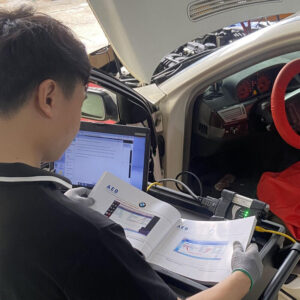
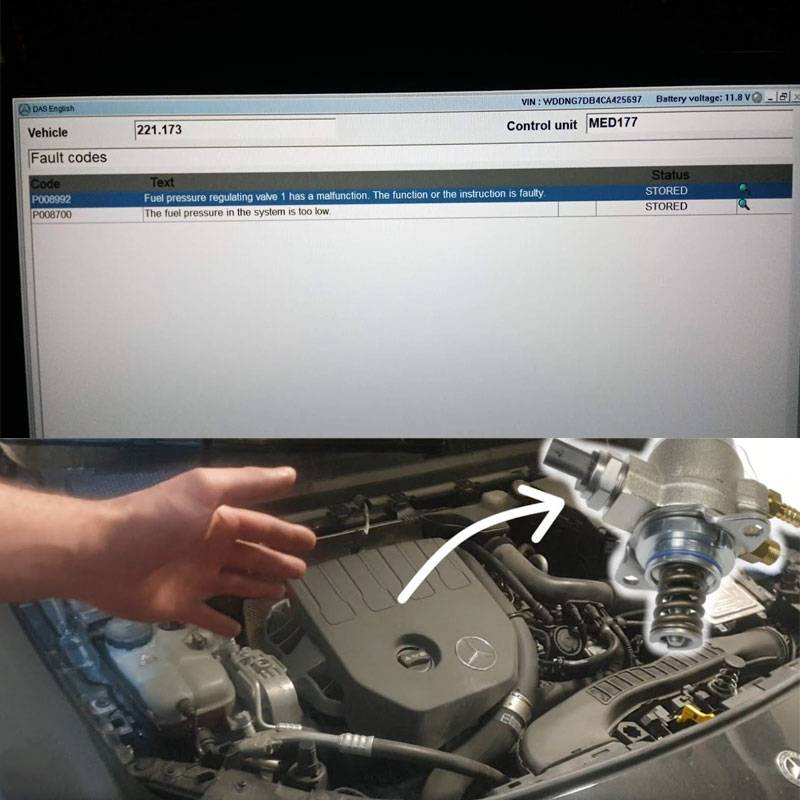
How to Fix Mercedes-Benz DTC P008700
Contents
- 1. What is Mercedes-Benz P008700 Diagnostic Trouble Code
- 2. The Vital Role of the Fuel System in Your Mercedes-Benz
- 3. Why P008700 Mercedes Fault Code Demands Immediate Attention
- 4. Symptoms of Mercedes-Benz DTC P008700
- 4.1 Primary Indicators:
- 4.2 Secondary Symptoms:
- 5. Common Causes of P008700 in Mercedes-Benz Vehicles
- 5.1 Fuel System Component Issues:
- 5.2 Electrical and Control Issues:
- 6. A Step-by-Step Guide to Diagnosing Mercedes-Benz P008700
- 6.1 Essential Tools for Diagnosis:
- 6.2 Detailed Diagnostic Process:
- 7. Implementing Effective Repair Solutions for P008700
- 7.1 Fuel Filter Replacement:
- 7.2 Fuel Pump Replacement:
- 7.3 Electrical System Repairs:
- 7.4 Control Module Solutions:
- 8. Proactive Steps to Prevent Mercedes-Benz P008700 Issues
- 8.1 Regular Fuel Filter Service:
- 8.2 Fuel Quality Management:
- 8.3 System Monitoring:
- Expert Help for Mercedes-Benz Diagnostics & Repairs
Experiencing the Mercedes-Benz DTC P008700 code can be concerning, but at autoexplain.com, we’re here to illuminate the path to resolving this “Fuel Rail/System Pressure Too Low” issue with clarity and expertise. This comprehensive guide dives deep into the intricacies of this diagnostic trouble code, offering Mercedes-Benz owners and automotive professionals the knowledge needed to diagnose and effectively repair fuel delivery system problems. Understanding the nuances of this fault, from identifying potential causes to implementing precise repair strategies, is crucial for restoring your vehicle’s optimal performance and ensuring your peace of mind on the road. Explore the world of Mercedes-Benz fuel systems with autoexplain.com and empower yourself with the insights to tackle this challenge head-on.
1. What is Mercedes-Benz P008700 Diagnostic Trouble Code
The appearance of the P008700 code in your Mercedes-Benz signals that the Powertrain Control Module, the intelligent heart of your vehicle’s engine management, has detected a concerning drop in the fuel pressure within the fuel rail or the broader fuel system. This isn’t just a minor inconvenience; it’s a clear indicator that the sophisticated common rail direct injection system, a hallmark of modern Mercedes-Benz engineering, isn’t receiving the vital fuel pressure it needs to operate effectively. This precise control over fuel pressure is paramount for achieving optimal engine performance, ensuring efficient combustion, and maintaining the refined driving experience you expect from your Mercedes-Benz.
When this pressure dips below a pre-determined threshold, the P008700 code is logged, prompting the illumination of the check engine light on your dashboard as a signal that attention is required. Recognizing this code is the first step towards understanding the underlying issue and initiating the necessary diagnostic and repair procedures to bring your Mercedes-Benz back to its peak performance.
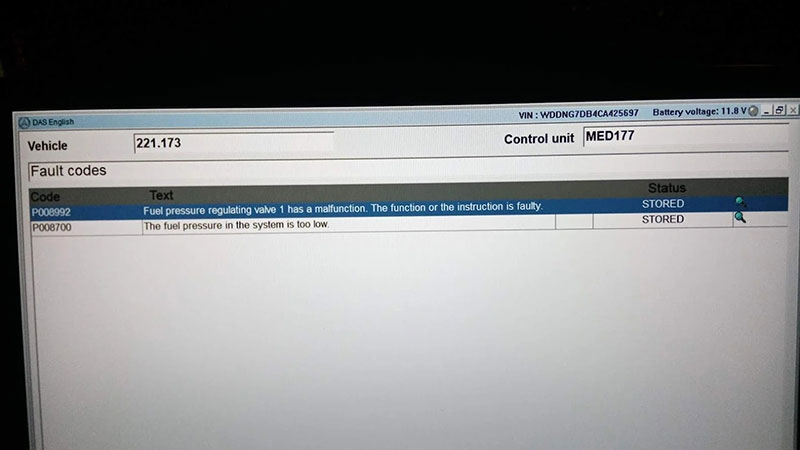
2. The Vital Role of the Fuel System in Your Mercedes-Benz
To truly grasp the significance of the P008700 code, it’s essential to understand the intricate workings of your Mercedes-Benz fuel system. Think of it as the lifeline of your engine, responsible for delivering the precise amount of fuel, at the correct pressure, to the combustion chambers.
Modern Mercedes-Benz vehicles, renowned for their technological sophistication, often employ a dual-pump fuel delivery system. This setup typically includes a low-pressure fuel pump, situated within the fuel tank, tasked with the initial job of drawing fuel from the tank and supplying it to the high-pressure fuel pump. The high-pressure fuel pump, usually mounted directly on the engine and driven by the engine’s camshaft, then takes over, dramatically increasing the fuel pressure to the levels required for the direct fuel injection system.
This high-pressure fuel is then distributed to the individual fuel injectors via the fuel rail. A dedicated fuel pressure sensor, strategically positioned on the fuel rail, constantly monitors the fuel pressure and relays this critical information back to the PCM. This real-time feedback loop allows the PCM to make adjustments to the fuel pump operation, ensuring that the fuel pressure remains within the optimal range for various driving conditions.
When the fuel pressure sensor reports a value below the acceptable minimum threshold, the P008700 code is triggered, indicating a potential disruption in this finely tuned system. Understanding this interplay between the components underscores why addressing the P008700 code promptly is so important for maintaining the health and performance of your Mercedes-Benz.
3. Why P008700 Mercedes Fault Code Demands Immediate Attention
The Mercedes-Benz P008700 diagnostic trouble code should not be taken lightly. It signifies a critical issue within the fuel delivery system that can have far-reaching consequences for your vehicle’s performance, safety, and longevity. Ignoring this code can lead to a cascade of problems, significantly impacting your driving experience and potentially causing costly damage to vital engine components.
When the fuel pressure is insufficient, the engine’s ability to generate power is severely compromised, resulting in a noticeable loss of performance, particularly during acceleration. In more severe cases, the engine may unexpectedly stall, creating a serious safety hazard, especially in high-speed or heavy traffic situations.
Furthermore, continued operation with low fuel pressure can strain other components of the fuel system, potentially leading to premature wear or failure. The delicate balance of the emissions control systems can also be disrupted, likely causing your vehicle to fail emissions testing. In essence, the P008700 Mercedes code is a red flag indicating a fundamental problem that needs to be addressed promptly by a qualified technician to prevent further complications and ensure the continued safe and reliable operation of your Mercedes-Benz.
4. Symptoms of Mercedes-Benz DTC P008700
When the Mercedes-Benz P008700 code is present, your vehicle will often exhibit a range of telltale symptoms that can provide valuable clues about the underlying issue. Being aware of these signs can help you recognize the problem early and seek professional assistance promptly.
4.1 Primary Indicators:
-
Illuminated Check Engine Light (MIL): This is often the first and most obvious sign that something is amiss. The check engine light illuminates on your dashboard to alert you to a detected problem within the engine management system.
-
Noticeable Loss of Power: You may experience a significant reduction in your vehicle’s acceleration and overall responsiveness, especially when trying to accelerate quickly or go uphill. The engine may feel sluggish and unable to deliver its usual power output.
-
Entry into Limp Mode: In some Mercedes-Benz models, particularly diesel variants like the W212 with the OM651 engine, the vehicle may enter a “limp mode” or reduced power mode. This is a safety mechanism designed to limit engine power and prevent further damage when a critical fault is detected. You might notice a significant restriction in engine speed and power.
-
Engine Misfires and Rough Running: The engine may run erratically, exhibiting misfires, vibrations, and an overall rough idle or during acceleration. This is due to the insufficient fuel pressure leading to incomplete or inconsistent combustion.
-
Difficulty Starting or No-Start Condition: In more severe cases, the lack of adequate fuel pressure can make it difficult to start the engine, or it may fail to start altogether. This is more commonly reported in models like the Sprinter and CLA.
4.2 Secondary Symptoms:
-
Increased Fuel Consumption: Ironically, low fuel pressure can sometimes lead to increased fuel consumption as the engine struggles to maintain performance.
-
Intermittent Stalling: The engine may stall unexpectedly, particularly at idle or during low-speed maneuvers.
-
Uneven Idle: The engine’s idle speed may fluctuate or feel rough and unstable.
-
Poor Throttle Response: The engine may be slow to respond when you press the accelerator pedal.
-
Complete Engine Cut-Out: In critical situations, the engine may completely shut off while driving, posing a significant safety risk.
Experiencing any of these symptoms in conjunction with the check engine light warrants immediate attention and a professional diagnosis to pinpoint the exact cause of the P008700 code and implement the necessary repairs.
5. Common Causes of P008700 in Mercedes-Benz Vehicles
The Mercedes-Benz P008700 code can stem from a variety of issues within the fuel system and related electrical components. A thorough understanding of these potential causes is crucial for effective diagnosis and repair.
5.1 Fuel System Component Issues:
-
Clogged or Dirty Fuel Filter: This is one of the most frequent culprits behind the Mercedes-Benz P008700 code. Over time, the fuel filter accumulates contaminants from the fuel, such as dirt, rust, and debris. A severely clogged filter restricts the flow of fuel to the high-pressure pump, leading to a drop in fuel rail pressure. This is often a relatively inexpensive fix but essential for maintaining optimal fuel system performance.
-
Fuel Pump Failures:
-
Weak or Failing Low-Pressure Fuel Pump (LPFP): Located in the fuel tank, the LPFP is responsible for supplying fuel to the HPFP. If the LPFP is weak or failing, it may not be able to deliver an adequate volume of fuel, causing the high-pressure pump to struggle and resulting in low fuel rail pressure.
-
Internal Wear or Damage to the High-Pressure Fuel Pump (HPFP): The HPFP is a critical component responsible for generating the extremely high pressures required for direct fuel injection. Internal wear, damage to seals, or issues with the pump’s internal mechanisms can significantly reduce its ability to build and maintain proper fuel pressure .
-
Fuel Pump Control Module Issues: In some Mercedes-Benz models, such as the CLA250, the fuel pump control module, which regulates the operation of the fuel pump, can fail, leading to insufficient fuel delivery and the P008700 Mercedes code.
-
-
Faulty Fuel Pressure Sensor: The fuel pressure sensor, situated on the fuel rail, provides crucial feedback to the PCM about the actual fuel pressure. If this sensor malfunctions and provides incorrect readings, the PCM may mistakenly believe the fuel pressure is low and trigger the P008700 code, even if the actual pressure is within the acceptable range. Conversely, a faulty sensor might fail to report a genuinely low pressure, but it’s more common for it to trigger a false low-pressure reading.
-
Worn Cam Follower: In Mercedes-Benz models where the high-pressure fuel pump is driven by a cam lobe on the engine’s camshaft, excessive wear on the cam follower (the component between the cam lobe and the pump plunger) can reduce the efficiency of the pump, leading to lower fuel pressure. This is more common in older or higher-mileage vehicles.
5.2 Electrical and Control Issues:
-
Blown Fuses: A seemingly simple issue like a blown fuse in the fuel pump circuit can prevent the fuel pump from operating correctly, leading to low fuel pressure. This has been specifically documented in Mercedes-Benz Sprinter models.
-
Wiring and Connector Problems: Issues such as corroded, damaged, or loose wiring or connectors in the fuel pump module, fuel pressure sensor circuits, or PCM connections can disrupt the electrical signals necessary for proper fuel system operation. This can lead to intermittent or consistent low fuel pressure readings and the triggering of the P008700 code.
-
PCM (Powertrain Control Module) Issues: While less common, in rare instances, a fault within the PCM itself can lead to incorrect fuel pressure control or misinterpretation of sensor signals, resulting in the P008700 code. Diagnosing a PCM issue typically requires advanced diagnostic procedures.
Understanding these potential causes provides a solid foundation for the diagnostic process, helping technicians to systematically investigate the fuel system and related components to pinpoint the exact source of the low fuel pressure.
6. A Step-by-Step Guide to Diagnosing Mercedes-Benz P008700
Accurately diagnosing the Mercedes-Benz P008700 code requires a methodical and comprehensive approach, utilizing the right tools and following a structured procedure. Generic OBD-II scanners often lack the depth of information needed for Mercedes-Benz vehicles, making Mercedes-specific diagnostic equipment essential.
6.1 Essential Tools for Diagnosis:
-
Mercedes-Benz Xentry/DAS/Star Diagnostic System: This is the primary diagnostic tool recommended for Mercedes-Benz vehicles. It provides in-depth system analysis, live data streaming, component testing capabilities, and access to Mercedes-Benz repair information.
-
Fuel Pressure Gauge Compatible with Mercedes Fuel Systems: A high-quality fuel pressure gauge, designed to handle the high pressures present in Mercedes-Benz common rail systems, is necessary for accurately measuring the fuel pressure at various points in the system.
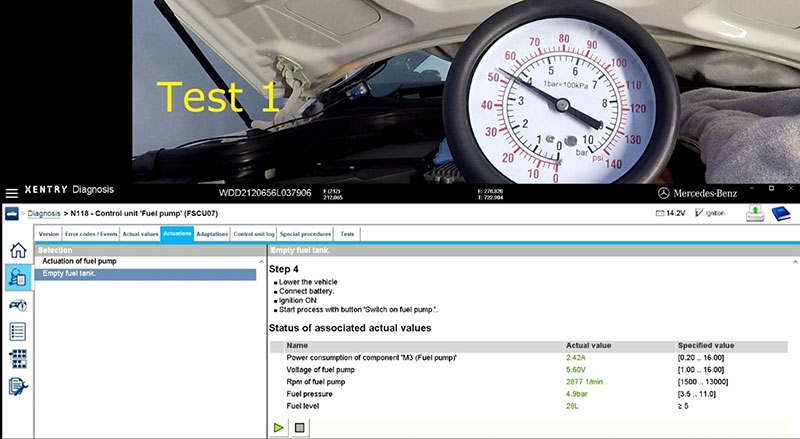
-
Digital Multimeter: A digital multimeter is essential for performing electrical tests, such as checking voltage, continuity, and resistance in the fuel pump circuits, sensor wiring, and connectors .
-
Access to Mercedes-Benz Repair Information: Having access to official Mercedes-Benz service manuals, technical service bulletins (TSBs), and wiring diagrams is crucial for understanding system specifications, troubleshooting procedures, and component locations.
6.2 Detailed Diagnostic Process:
-
Preliminary System Scan and Data Collection:
-
Begin by performing a complete system scan using the Mercedes-Benz diagnostic system. It’s important to check for all stored diagnostic trouble codes, not just those related to the engine control module.
-
Carefully record and analyze the freeze frame data associated with the P008700 Mercedes code. This data captures the engine operating conditions at the moment the fault was detected, providing valuable context for troubleshooting.
-
Note any other related diagnostic trouble codes that may be present, as these can offer additional clues about the underlying problem.
-
Clear all stored diagnostic trouble codes and perform a test drive under various driving conditions to see if the P008700 code reappears. This helps determine if the fault is intermittent or persistent.
-
-
Comprehensive Fuel Pressure Testing:
-
Connect the Mercedes-Benz diagnostic system to the vehicle and monitor live fuel pressure data. Pay close attention to both the low-pressure side (from the in-tank pump) and the high-pressure side (at the fuel rail).
-
Compare the actual fuel pressure readings against the manufacturer’s specifications for your specific Mercedes-Benz model and engine. These specifications can be found in the Mercedes-Benz repair information.
-
Observe the fuel pressure readings during different engine operating conditions: during cranking, at idle, and during acceleration. Note any significant drops or fluctuations in pressure.
-
Use the fuel pressure gauge to physically measure the fuel pressure at the fuel rail. Compare this reading to the live data from the diagnostic system to verify the accuracy of the fuel pressure sensor .
-
-
Thorough Component Inspection:
-
Fuel Filter: Check the fuel filter service history. If it hasn’t been replaced according to the recommended intervals, or if there’s reason to suspect fuel contamination, inspect the filter for excessive dirt or blockage.
-
High-Pressure Fuel Pump (HPFP): Visually inspect the HPFP for any signs of external leaks or physical damage.
-
Fuel Lines and Connections: Carefully examine all fuel lines and connections for any signs of restrictions, leaks, kinks, or damage.
-
Electrical Connections: Inspect the electrical connectors at the fuel pump module, fuel pressure sensor, and PCM for any signs of corrosion, damage, or loose connections .
-
-
Detailed Electrical System Checks:
-
Fuel Pump Voltage: Use the digital multimeter to verify that the fuel pumps (both low-pressure and high-pressure, if accessible) are receiving the correct voltage from the vehicle’s electrical system. Check the voltage at the fuel pump connectors with the ignition on and while the engine is cranking.
-
Fuses: Check all fuses related to the fuel system in the vehicle’s fuse boxes for any blown fuses. Refer to the vehicle’s owner’s manual or a wiring diagram to identify the correct fuses.
-
Fuel Pump Relay: If applicable, test the operation of the fuel pump relay. This may involve checking for proper coil voltage and continuity of the switch contacts.
-
Wiring Harness: Carefully inspect the wiring harness leading to the fuel pump module, fuel pressure sensor, and PCM for any signs of damage, chafing, or corrosion . Pay particular attention to areas where the wiring harness may be routed near sharp edges or hot engine components.
-
By diligently following these diagnostic steps and utilizing the appropriate tools, Mercedes-Benz technicians can effectively pinpoint the root cause of the P008700 code and proceed with the necessary repairs.
7. Implementing Effective Repair Solutions for P008700
Once the underlying cause of the Mercedes-Benz P008700 code has been accurately diagnosed, the next step is to implement the appropriate repair solution. The specific repair will depend on the faulty component or system identified during the diagnostic process.
7.1 Fuel Filter Replacement:
-
If a clogged or restricted fuel filter is identified as the culprit, the solution is a straightforward replacement.
-
Always use a genuine Mercedes-Benz fuel filter or a high-quality equivalent that meets the manufacturer’s specifications.
-
After replacing the fuel filter, perform a system pressure test using the Mercedes-Benz diagnostic system to verify that the fuel pressure has returned to the correct range and that the P008700 code does not reappear.
7.2 Fuel Pump Replacement:
-
Low-Pressure Fuel Pump (LPFP): Replacing the LPFP typically involves accessing the fuel tank. On some Mercedes-Benz models, this may require removing the fuel tank entirely, while on others, access can be gained through an access panel under the rear seat [7]. Ensure the fuel system is depressurized before starting this procedure.
-
High-Pressure Fuel Pump (HPFP): Replacing the HPFP, which is mounted on the engine, requires careful attention to detail. In cam-driven pumps, proper timing alignment is crucial during installation to ensure correct fuel delivery phasing. Always refer to the Mercedes-Benz service manual for the specific installation procedure for your vehicle’s engine.
-
When replacing either the LPFP or the HPFP, it’s good practice to inspect the associated fuel lines and connectors. If any show signs of wear, damage, or leaks, they should also be replaced to ensure a reliable seal and prevent future issues.
7.3 Electrical System Repairs:
-
Blown Fuses: If a blown fuse is found to be the cause, replace it with a new fuse of the correct amperage rating. It’s important to investigate why the fuse blew in the first place to prevent recurrence.
-
Wiring and Connector Issues: Repairing damaged wiring should be done using Mercedes-Benz-specified methods, such as proper soldering and insulation. Corroded connectors should be replaced entirely rather than attempting to clean them, as cleaning may not restore a reliable electrical connection. Ensure all connections are secure and properly seated.
7.4 Control Module Solutions:
-
Fuel Pump Control Module Replacement: If the fuel pump control module is diagnosed as faulty (as can occur in models like the CLA), it will need to be replaced with a new, genuine Mercedes-Benz module. This often requires specialized programming using the Mercedes-Benz diagnostic system to integrate the new module with the vehicle’s electronic control units.
-
PCM Reprogramming or Replacement: In the rare cases where the PCM is identified as the source of the problem, reprogramming the PCM software or replacing the unit entirely may be necessary. PCM replacement typically requires coding the new unit to the vehicle’s specific configuration.
After any repair is completed, it is crucial to clear all diagnostic trouble codes using the Mercedes-Benz diagnostic system and perform a thorough test drive under various operating conditions to ensure that the P008700 code does not return and that the vehicle is performing as expected. Monitoring live fuel pressure data during the test drive can help confirm the effectiveness of the repair.
8. Proactive Steps to Prevent Mercedes-Benz P008700 Issues
While the Mercedes P008700 code indicates an existing problem, Mercedes-Benz owners and service professionals can take proactive steps to minimize the risk of fuel system issues and help prevent this code from appearing in the first place.
8.1 Regular Fuel Filter Service:
-
Adhere strictly to the manufacturer-recommended fuel filter replacement intervals outlined in your Mercedes-Benz owner’s manual or service schedule.
-
Consider more frequent fuel filter changes if you regularly drive in areas known for lower fuel quality or if you suspect fuel contamination. A clean fuel filter is essential for maintaining proper fuel flow and protecting the sensitive components of the fuel system .
8.2 Fuel Quality Management:
-
Consistently use high-quality fuel from reputable gas stations. Avoid using fuel from unfamiliar or unreliable sources.
-
Try to maintain at least a quarter tank of fuel in your vehicle at all times. This helps to keep the in-tank fuel pump submerged, which aids in cooling the pump and preventing it from overheating, potentially prolonging its lifespan.
8.3 System Monitoring:
-
Pay close attention to your vehicle’s dashboard and address any illuminated check engine lights promptly. Even if the symptoms seem minor, a diagnostic scan can reveal underlying issues before they escalate.
-
Consider having periodic comprehensive diagnostic scans performed, even if you are not experiencing any noticeable symptoms. This can help identify potential problems early, including subtle fluctuations in fuel pressure, before they trigger a fault code like P008700.
By incorporating these preventative maintenance practices into your regular vehicle care routine, you can significantly reduce the likelihood of encountering fuel system problems and the associated P008700 diagnostic trouble code, helping to ensure the continued reliability and performance of your Mercedes-Benz.
Expert Help for Mercedes-Benz Diagnostics & Repairs
If you’re struggling with P008700 or other Mercedes-Benz fault codes, our team at AutoExplain can help! We specialize in car diagnostics, coding, and programming support for all Mercedes-Benz models.
📌 Why Choose AutoExplain?
✅ 24/7 Online Support – Get expert guidance anytime.
✅ Professional Car Diagnostic Services – We use Mercedes STAR/Xentry tools.
✅ Quick and Reliable Fixes – Minimize downtime and repair costs.
📞 Contact us now via WhatsApp: +1(936)2896695 🌐 Visit our website: AutoExplain
Get your Mercedes-Benz running smoothly again—contact us today! 🚗💨

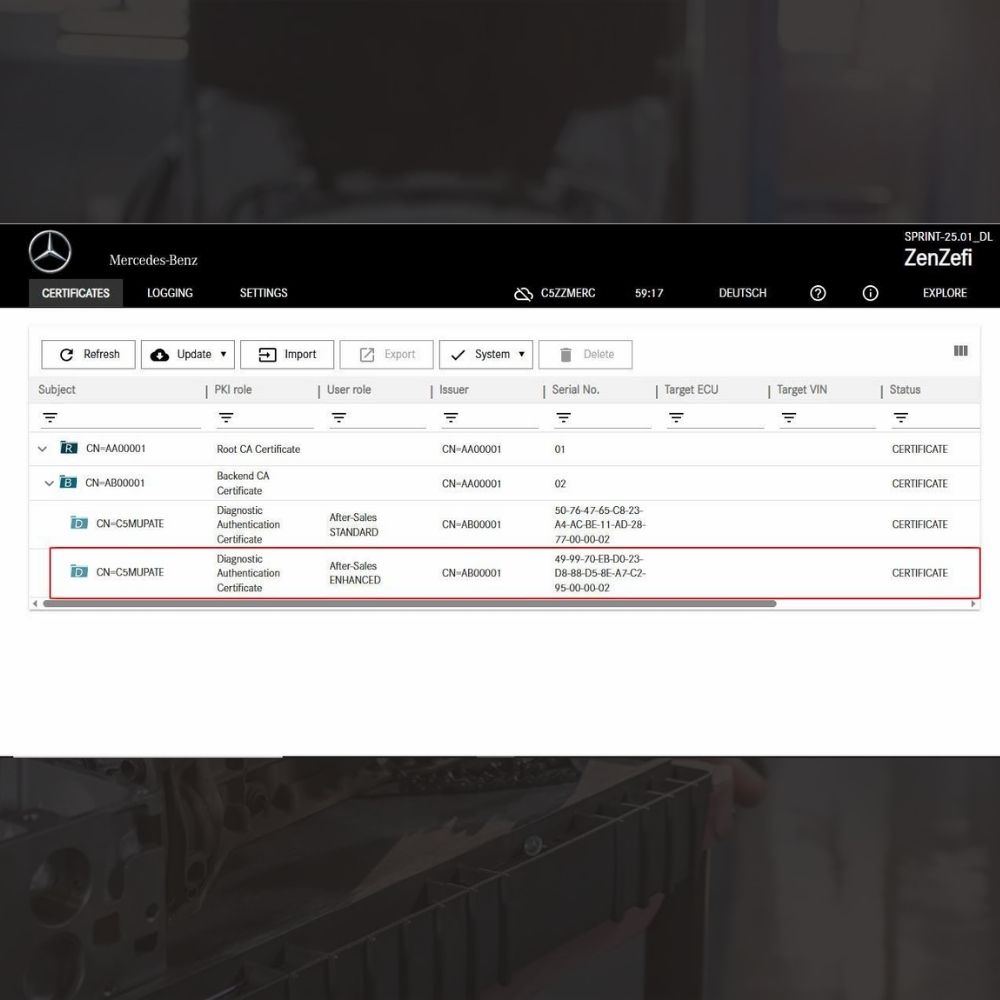
New Mercedes Car Coding Solution with ZenZefi certificate for DTS Monaco 9.02

What is DTS Monaco? Key Functions of DTS Monaco Software
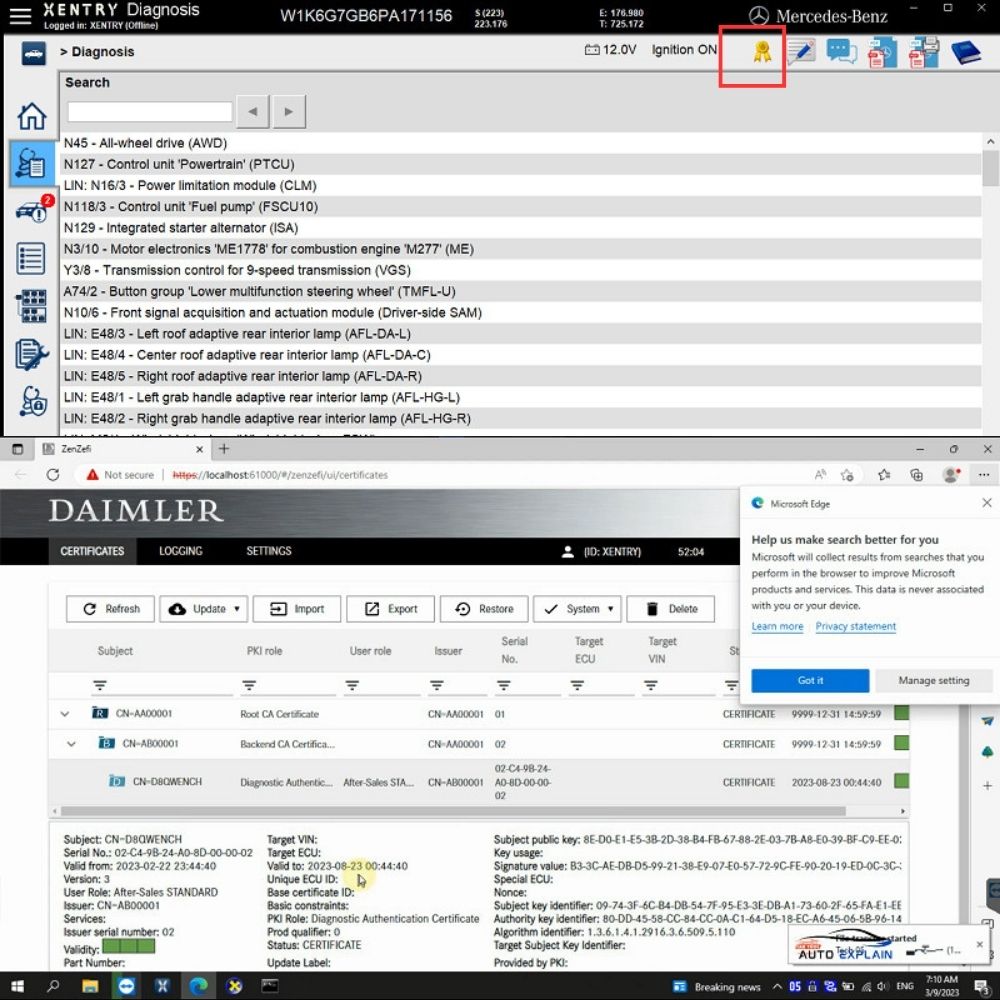
What is the Xentry Certificate Zenzefi? Why You Need It, and When It Is Required?



New Mercedes Car Coding Solution with ZenZefi certificate for DTS Monaco 9.02



